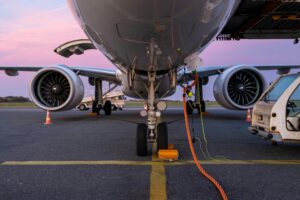Nigeria stands at a critical aviation crossroads. The Minister of Aviation recently requested master plans for five international airports, seemingly forgetting a fundamental reality: the Federal Airports Authority of Nigeria (FAAN) manages 21 airports nationwide. This narrow focus raises alarming questions about the future of the other 16 airports and reveals a concerning lack of understanding about how Nigeria’s airport system actually functions.
The fragmented approach threatens to undermine the entire national aviation infrastructure at a time when Nigeria desperately needs comprehensive reform. Aviation expert Sindy Foster puts it bluntly: “This is completely the wrong way to go.”
The Missing Pieces in Nigeria’s Airport Puzzle
The minister’s approach lacks crucial context. By concentrating exclusively on five international facilities, the government misses the interconnected nature of airport operations. Foster emphasizes that without examining the whole system, particularly regarding “revenue generation, cross subsidisation, sunset airports, and airport viability,” any resulting recommendations will be fundamentally flawed.
The question hanging over the aviation sector is stark: Can the 16 regional airports operate without revenue from the five international hubs? The answer impacts communities across Nigeria that depend on air connectivity for economic development, healthcare access, and regional integration.
Nigeria’s airport system doesn’t operate as 21 independent units but as an interconnected network. Major international airports like Lagos and Abuja effectively subsidize smaller regional facilities that serve vital public functions despite generating less revenue. Breaking this delicate ecosystem without understanding it first courts disaster.
Policy Development, Not Direct Intervention
Many stakeholders mistakenly expect the minister to directly “make airports viable.” Foster challenges this assumption, arguing that the minister’s primary responsibility is policy development, not operational management.
“It really isn’t for the Minister to make anything viable. His focus should be on policy,” Foster states. “What in the policies is making airports unviable? What does unviable mean in the context of the airports? What is the benefit to the States?”
These questions reveal the complexity beneath simplistic approaches to airport development. The solution requires engagement with aviation professionals, stakeholders, state governments, and businesses with vested interests in these facilities. Top-down directives without stakeholder input have repeatedly failed in Nigeria’s aviation sector.
Beyond Infrastructure: The Traffic Challenge
The common assumption that better infrastructure automatically generates traffic misunderstands aviation economics. Foster points out that “infrastructure alone cannot generate traffic.”
Attracting airlines and passengers depends on multiple factors beyond physical facilities. Surface access, security conditions, operational costs, operating hours, and available destinations all influence an airport’s viability. Building gleaming terminals in locations without sufficient demand or connectivity creates expensive monuments, not functioning airports.
Nigeria’s regional airports struggle with traffic and revenue for complex reasons. Some serve areas with limited economic activity. Others face competition from road transportation or suffer from security concerns that deter travelers. Many operate with restricted hours that make them unattractive to airlines seeking to maximize aircraft utilization.
These challenges require nuanced solutions, not one-size-fits-all approaches.
The Path Forward: Customized Solutions
Foster advocates for a comprehensive audit of all 21 airports as an essential first step. “Without that, no one knows the full picture,” she explains. This assessment would provide the factual foundation currently missing from policy discussions.
Nigeria must abandon the notion that identical solutions will work across its diverse airport network. “Nigeria needs to stop thinking one size fits all in aviation,” Foster advises. “Just as airlines need to have their own business plans, so do airports. What is appropriate for Lagos, may not be appropriate for Owerri.”
This tailored approach acknowledges the vastly different circumstances facing each airport. Lagos, with its massive population and status as Nigeria’s commercial center, naturally attracts international carriers and domestic traffic. Smaller regional airports may need to focus on specific market segments, cargo operations, or serving as feeders to major hubs.
Local needs require local solutions. Some regional airports might benefit from state government partnerships. Others could focus on specialized cargo operations supporting agricultural exports. Still others might operate on reduced schedules aligned with peak demand periods rather than maintaining costly 24-hour operations.
Stakeholder Engagement: The Missing Link
The minister’s current approach appears to bypass critical stakeholders who understand ground realities. Foster strongly urges him to “engage with stakeholders who would help him” develop effective policies.
These stakeholders include airline operators who make route decisions, local business communities who generate passenger and cargo demand, state governments with economic development plans, and aviation professionals who understand operational constraints. Their perspectives provide the context necessary for meaningful reform.
Without this engagement, Nigeria risks repeating past failures in airport development – building infrastructure disconnected from market realities, implementing policies that airlines cannot profitably operate under, or creating regulations that impede rather than facilitate growth.
The Strategic Imperative
Nigeria’s aviation sector stands at a defining moment. With the right approach, the country could develop an airport network that drives economic growth, connects underserved regions, and positions Nigeria as West Africa’s aviation hub. With the wrong approach, Nigeria risks wasting resources on showcase projects while regional connectivity deteriorates.
Foster frames the challenge clearly: “Understanding where you are, and knowing where you want get to, helps to effectively plan your direction.” Nigeria’s aviation leadership first needs an honest assessment of current realities before charting a path forward.
The five international airports currently receiving the minister’s attention are important, but they exist within a broader ecosystem. Their success depends partly on the health of regional airports that feed them passengers and extend air connectivity throughout Nigeria. Ignoring this reality threatens the entire system.
As Nigeria contemplates the future of its aviation sector, the fundamental question isn’t just what to do with five international airports, but how to develop an integrated system that serves the entire country’s needs. The answer begins with comprehensive understanding, not partial solutions.
Disclaimer: The insights shared in this article are for information purposes only and do not constitute strategic advice. Aviation markets and circumstances vary, and decisions should be based on your organisation’s specific context. For tailored consultancy and guidance, please contact info@avaerocapital.com.




